Round two of this set of blog updates, this is the chapter I like to refer to as “Dust, Pain and Exhaustion: Oh God, Not Another Boatyard”, or perhaps “How I Spent My Summer Vacation: Part Four”. It was a couple of months of hard labour in unpleasant working conditions, but we got through it and have a stronger, faster, more capable boat as a result.

We hauled out at ‘Talleres Navales Bercovich’, under the supervision of the main boss, Abel. That’s not Abel on the trailer – that’s Mark, or ‘Tarzan’, who was a great deal of help to us tracking down materials and figuring out random problems.

The guys in the boatyard were extremely capable with their equipment, and managed to back us through about a hundred meters of very, very cramped quarters between many other boats being stored for the summer months.

Once we had the bottom powerwashed and the boat blocked, we got started – clearly we had hit the bottom at some point. Whether it was dragging anchor in Tsehum Harbour in Sidney BC, or maybe when we dragged anchor in the A9 anchorage in San Diego, at some point we tore a bunch of fiberglass off the bottom of the rudder and the skeg on which it was hung. Time to grind it out and patch it over with new glass.

Miya took on the topsides as her main project – there were dozens of places where the 25-year-old fiberglass had cracked from expansion or been worn through or damaged, and each of those spots would have to be ground out, fiberglassed, sanded, faired, sanded, primed and painted.

We picked up a very nice new bathroom hatch at Second Wave, a used-sailing-gear store in Seattle, but I had never yet had the chance to properly install it. The old hatch coping had to be cut away, and a new lip had to be fabricated approximately one inch smaller than the old one, and then the whole thing would need fiberglassing for waterproofedness. This was a task I had been looking forward to for over a year!
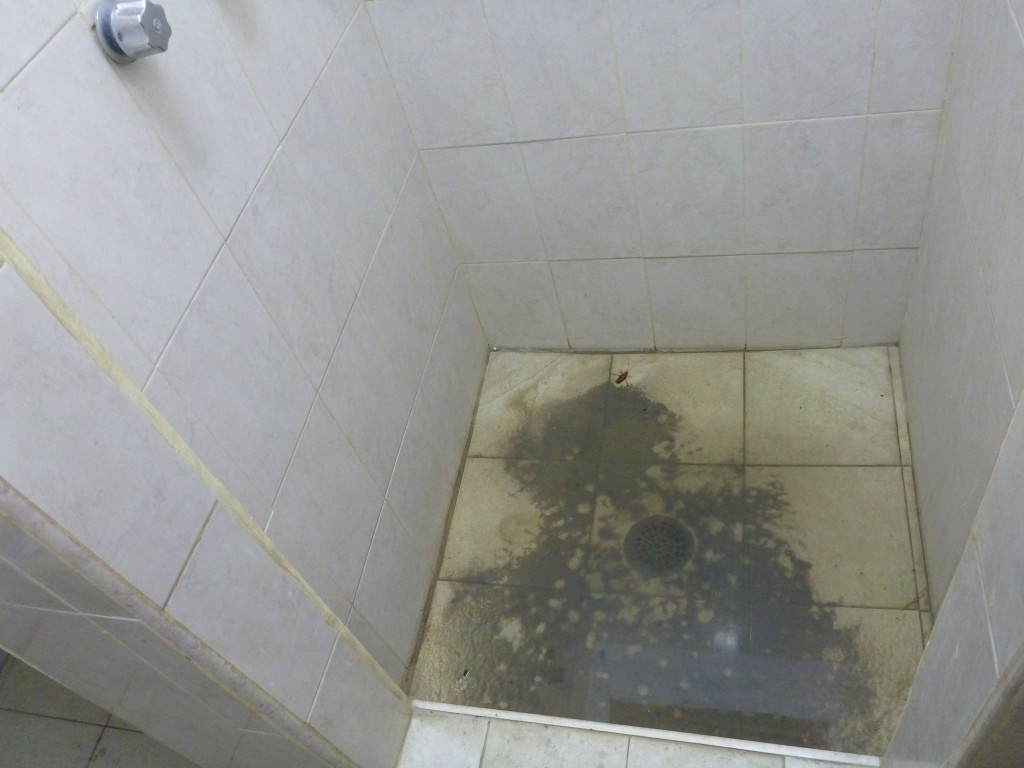
Working in a boatyard quickly drops your standards – at the end of a day of grinding fiberglass a shower is critical, but this is what we had to look forward to… two inches of stagnant water and a large dead cockroach. If you were lucky you got to the showers before the sun went down – as soon as the site cooled off, the mosquitoes would descend in a cloud!

Miya continued to work on fiberglass patches, while I worked on structural patches on the hull. We had to make several trips to the marine store for more epoxy resin – we went through three large gallon-sized tins of resin (and accompanying tins of hardener), each costing about $180 USD.

You can barely make me out in this photo, but I’m working away under the port wing, patching ground-out blisters and bubbles in the hull fiberglass. The garden is still going strong at this point; you can clearly see the carrots growing out the rear window.

Eventually I realized that the rudder had more damage than previously thought, and it made a lot more sense to remove it to work on it. It also made sense to spend time overdrilling all the previous mounting holes, filling them with epoxy, and re-drilling them, giving the hard-working rudder a much stronger connection to the fitting hardware.

The swing-keel on a Searunner trimaran is simultaneously one of the best and worst features of the boat. It’s the best feature, because it allows us to float happily in one meter of water, but if the keel gets damaged it’s a real hassle to pull it out to repair it. The binnacle (the pedestal the steering wheel is mounted on) has to be completely removed, which means disconnecting the steering, the engine controls and a bunch of wires.. and then you have to drag the filthy thing up across the decks and lower it to the ground for repair. Our keel, being waterlogged from breaks in the fiberglass, weighed about 200kg!

The boatyard was apparently quite quiet while we were in residence, though there were a few longtime denizens to spend time with – shown here is Doug from Snug Harbour Sails, a salty old sailor who would come visit with us regularly and made the time in the boatyard markedly more bearable.
This photo was also taken shortly after the sun drove me a little bit nuts, and haircut one of two occurred… Miya helped, but mostly it was me sitting under the boat with the clippers removing the bulky weight of hair that was nothing but a liability in the yard.

Project after project slowly got done. For instance, those pointy nails in the ceiling of the bathroom, the ones that punctured both Miya and my head on numerous occasions? TERMINATED.

The more time you spend looking at the bottom of a boat like the TIE Fighter, the more damage you realize you have to repair. Looks like another bit of rock-rash here that’ll need to be ground out and fiberglassed.

At the end of eight-to-ten hours of hard labour, punctuated by the occasional break to jump in the nearby ocean to cool down, there’s very little that can be done besides crashing hard. In this photo you can also see the ill-fated broccoli plant on the right side of the garden, attempting to take over the rear cabin… we never did get any broccoli crowns from that plant.

At some point we realized that if we wanted to continue being sane, rational humans, we’d need to take a break from all this work. We packed up our things and took a shuttle bus back into La Paz, where we spent the day wandering and doing our best tourist impressions, much to the delight of the locals. Many margueritas later, we stumbled back into the boatyard.

During our time away, we paid a visit to Sea Otter Jimmy, a local with the same make and model boat as ours (though in MUCH better shape!). Jimmy’s boat, s/v Sea Otter, had four more deck hatches than ours, giving him a tonne more wet-storage space for line, cleaning supplies, beach toys or whatever. We were jealous, so we took a bunch of measurements and decided to cut hatches into the TIE Fighter.
My tan is getting deeper and deeper…
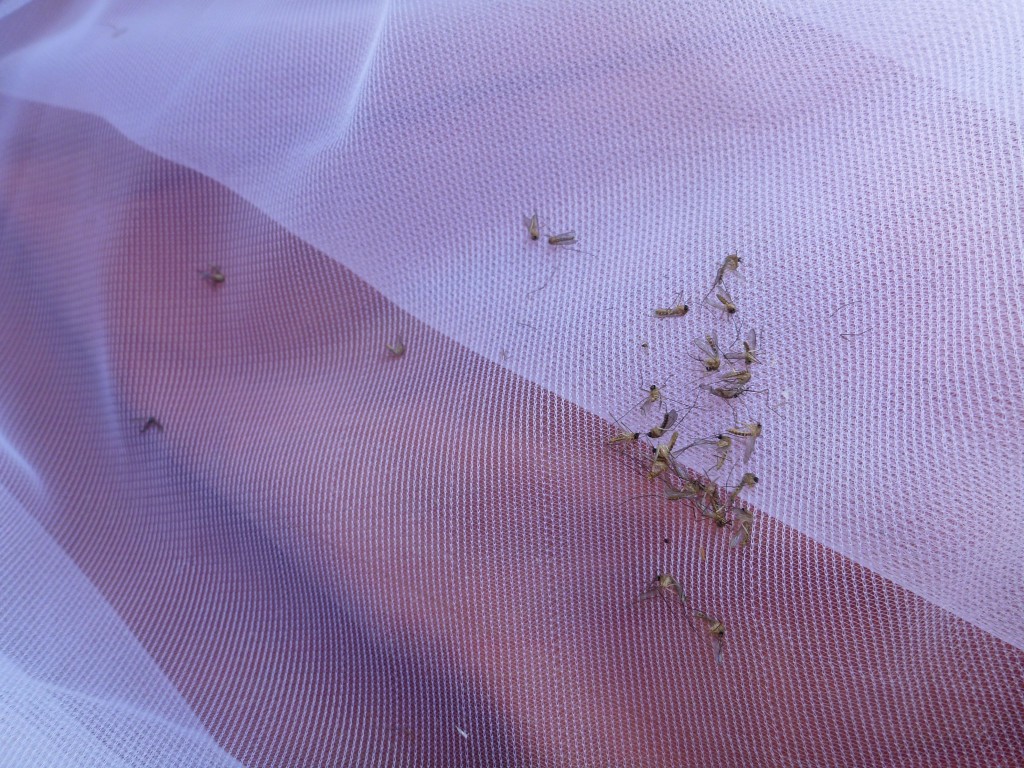
The mosquitoes in the boatyard were TERRIBLE – and the TIE Fighter, having no sealing hatches (not that you’d want them anyway, the boat would become a sauna), was the idea place for them to congregate. Miya visited the fabric store and returned with this sheer fabric, which she made a series of overlapping mosquito screens with, hot-glueing them to the walls of the cabin around the opening to our berth. Several iterations later, we finally had our first good night of sleep.
This photo is just the ones we found dead at the bottom of the mesh at the end of the first night!

When I finally got around to grinding out the problems in the swing keel, as I ground around the edge of the keel the laminated plywood suddenly jumped apart, leaving me with a giant, heavy, waterlogged, delaminated mess. It was time to face the facts: that keel was finished, and a new one would have to be built.
I went to town and found a place selling plywood – I had six sheets shipped in, cut them into the shapes I needed and coated them liberally with epoxy glue, then laminated them all together by weighting them with heavy rocks while the glue dried. I also destroyed our angle grinder during the “shape the newly-laminated raw keel into a foil shape” stage of the construction.

The hatches for the newly-cut wet storage lockers are here drying in the sun, fiberglassed but not yet sanded or painted. I was pretty proud of my carpentry work on these – the hatches fit really nicely, and the extra locker space is definitely appreciated.
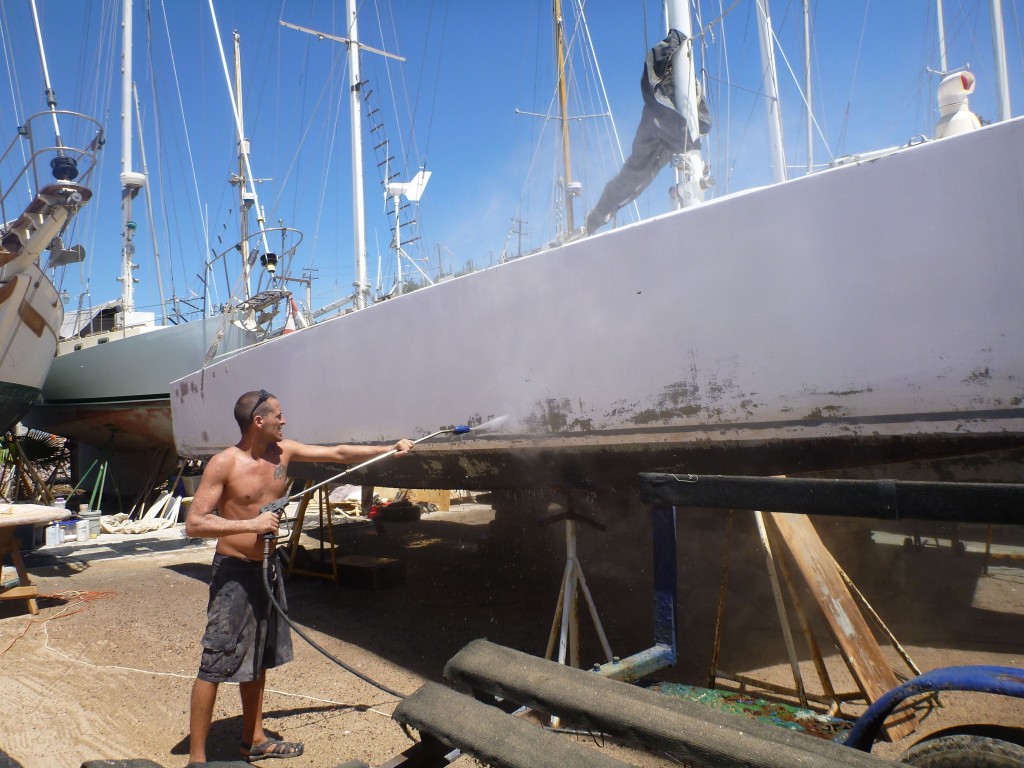
A month in, I finally convinced the yard that the best way to take off the old paint would be to rent me their largest power washer, which I knew would take the previous coat of (non-sticking) paint off, leaving the previous coat of (very good) two-part epoxy primer behind. The power washer was 7,000psi – compare if you will to the strongest power washer available at Home Depot being 4,000psi!
Also notable in this photograph are the second boatyard haircut, taking my hair down from the #4 clippers to the #1 clippers, or 1/8″, and the fact that all the hard labour has kicked in and I’m looking a lot more ripped than before the boatyard. 😀

Sadly, I was very much correct about the paint on the topsides coming off with the power washer… but with the exposure of the grey primer came exposure of dozens – no, hundreds – of new problems with the fiberglass. It didn’t help that the power washer also tore away any weakened fiberglass, probably creating at least half of those new problems, though it was pretty clear that those problems would have surfaced sooner or later anyway.
You can also see a bit of brown in the bottom right of the photo – Miya spent days on end repairing all the damage to the bows done by dragging the anchor chain up over the edges of the bows. We finally have a bow roller now, and will get around to installing it sometime in the near future.

With all the new patches, it almost seemed like we would have been ahead of the game to strip off the entire deck and replace the fiberglass, but it was a bit late for that – not to mention the price of fiberglass and epoxy in Mexico is prohibitive!

Another shot of the deck with all the new patches opened – before powerwashing we were pretty sure we were almost done with ‘glassing the deck! It would have saved a lot of time if we’d been allowed access to the power washer much earlier on, but there wasn’t much point in getting mad about it.

One of the big under-the-boat tasks was to replace the cutless bearings, rubber sleeves that hold the propellor shaft steady and perfectly aligned. Unfortunately to do this you really need to remove the propellor shaft, and I’d never done that before. Here Mark is heating up the propellor shaft coupling with a torch.

Miya’s constant sanding, sanding, sanding of the deck earned her the nickname “Lady Polvo”, where ‘polvo’ is spanish for dust or powder. The more we sanded, the more we had to jump into the ocean, which you can see about twenty meters behind Miya.
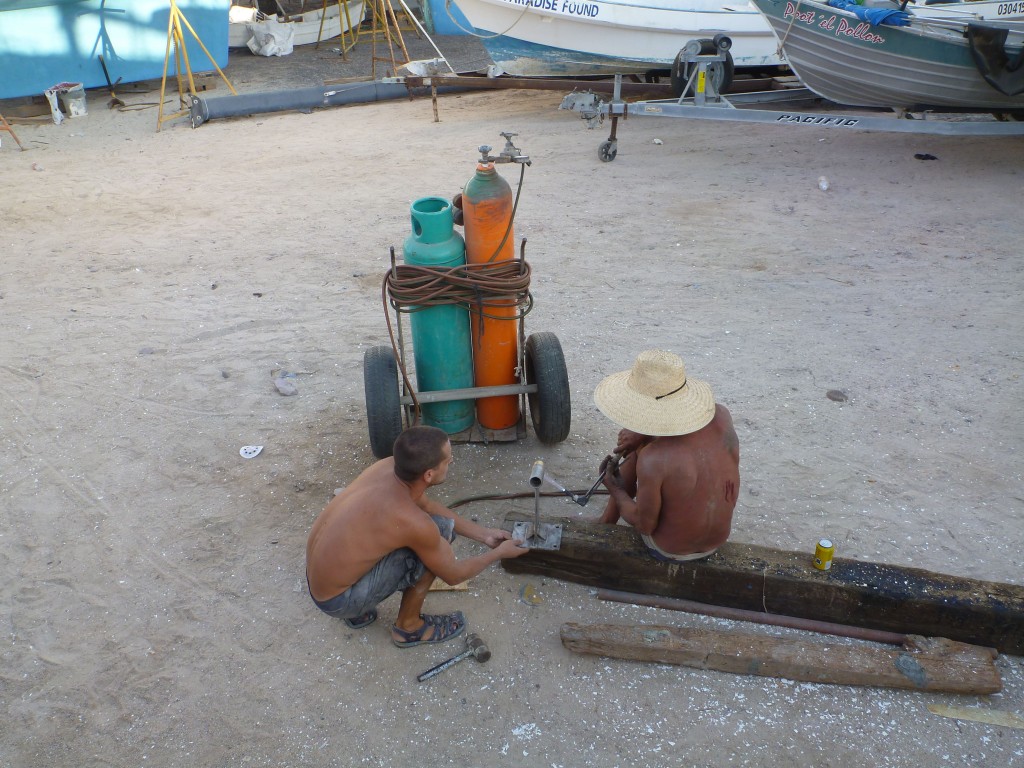
Once the replacement cutless bearings were acquired, the old worn-out bearings had to be removed. This I accomplished without much hassle, but when I went to put in the new bearing it seized halfway up the shaft – no matter how much I hammered it, it just wasn’t going back in. I had the bright idea of heating up the stainless steel strut to make it expand and free up the brass bearing sleeve, but the end result was that the rubber part of the bearing separated from the brass part, rendering the bearing unusable. Nuts – that was a waste of a hundred bucks.
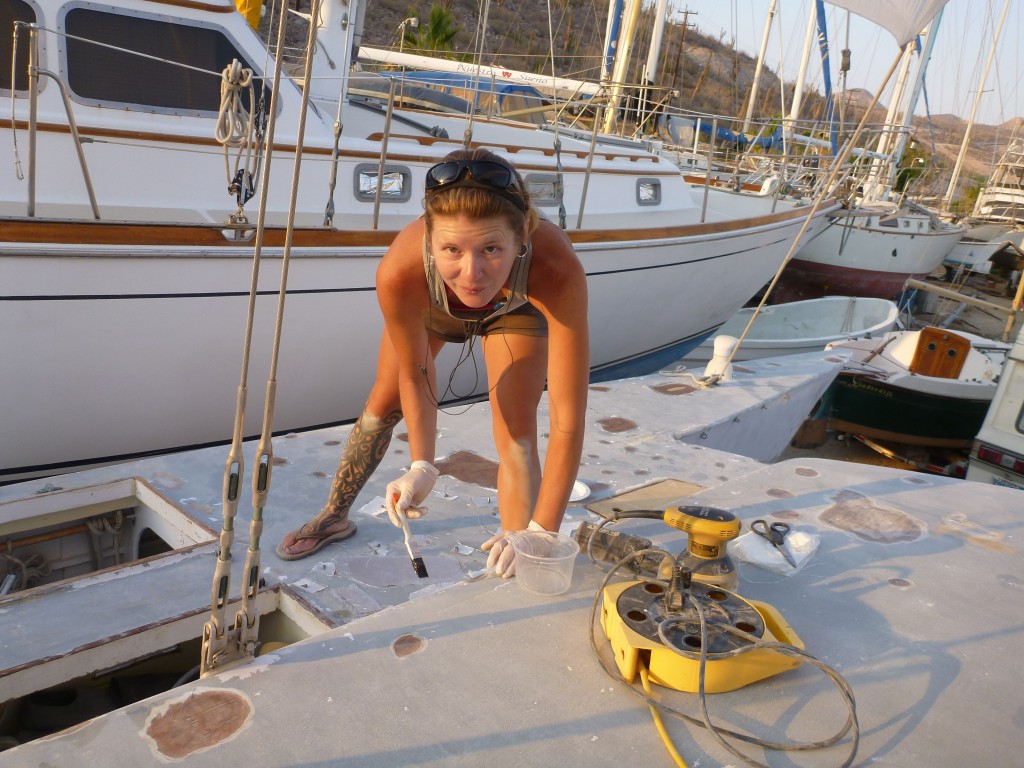
Miya, stalwartly continuing to patch all the deck problems. She was at this all day, every day, for weeks.

I finally finished up the patching and repairing of the rudder, and eventually we tracked down a new rubber gasket for the steering assembly – the black rubber bit in the center of the photo is actually the boot from the gear shift of a Mack truck, found at a place called “Diesel Professional” in La Paz!
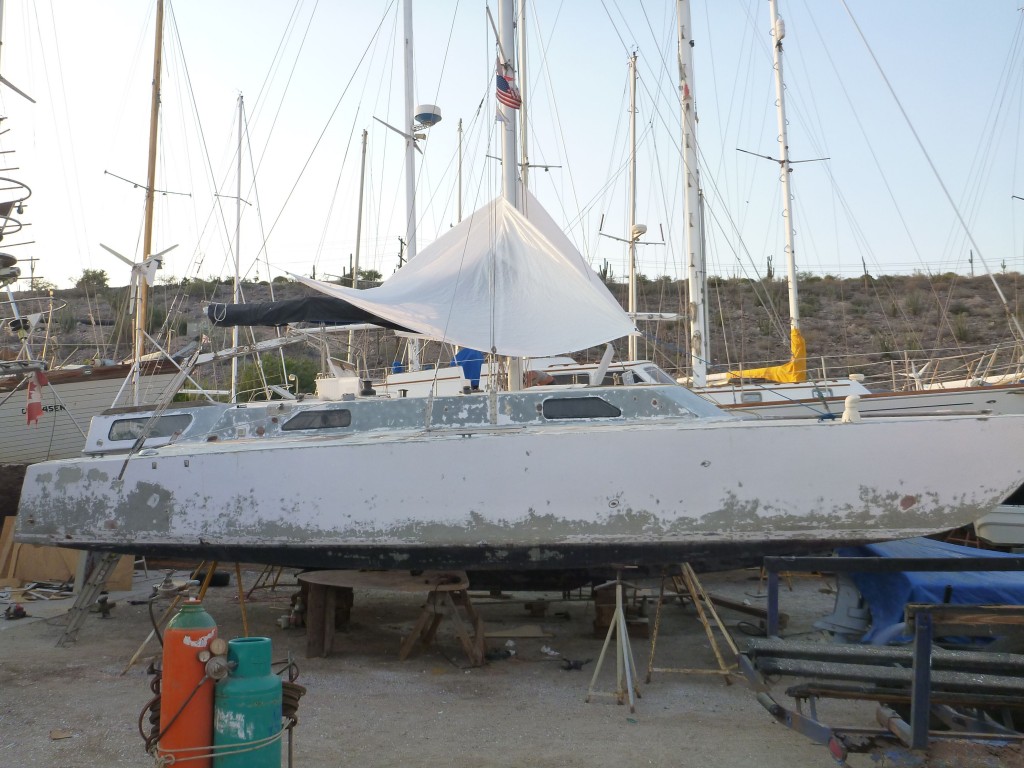
It can be difficult to keep your spirits up when you’ve been working your fingers to the bone for over a month, and the boat looks far worse than it did when you arrived… but in reality she’s much closer to finished.

…although now that we had to tear apart the kitchen to access the steering gear to reattach the rudder, there was a domino effect throughout the boat, and the normally tidy interior just kept getting more and more cluttered with tools and equipment.

This is the deck, two steps away from being finished. All of the brown patches are epoxy thickened with a talc-like powder, turning it into a fairing compound that flattens nicely and is very easy to sand. One more round of sanding, then a splash of primer, then another quick sand and she’d be ready for her final paint job!

Sadly I didn’t take more photos of the swing keel during the construction process, but needless to say I was several long days under the boat with a large industrial-size angle grinder and an eight-inch 60-grit sanding disc, shaping the plywood laminate into a smooth foil. Two layers of 8oz fiberglass over the whole thing, then a PVC tube glassed into the pivot point to protect the wood, and finally several coats of industrial-grade two-part epoxy primer, and we’re left with a swing-keel that should last for the rest of the life of the boat.

Once the fairing was sanded and the primer applied, a quick sand to make it all smooth and it’s time to wash down the decks in preparation for the first coat of her final paint job!

After seeing all the big freighters and fishing boats offshore, we realized that our little wooden boat probably didn’t show up all that well on radar, especially with our little metal ball-type radar reflector mounted six feet off the cabin roof. We did a bunch of research and settled on an EchoMax 230 reflector, that I mounted just above the staysail stay. Apparently this will make us look HUGE on a radar screen!

Once all the prep work was complete, the painting of the boat went very quickly, and we were done within two days. The bottom was taped and painted by the yard, but we rolled on three coats of latex-based housepaint quickly and efficiently.
In retrospect we probably should have just bitten the bullet and paid for the more expensive two-part epoxy paint. House paint is cheap and non-toxic, but it never really hardens completely, and you’re left with more of a latex “skin” over the entire boat. Time will tell if this was a nightmare decision, but currently in the dry southern tip of Baja it is working out acceptably – there have been a few instances of the paint becoming tacky in wet weather though, and I am a bit nervous to see what will happen in damper climates, like the rainy season of Costa Rica.
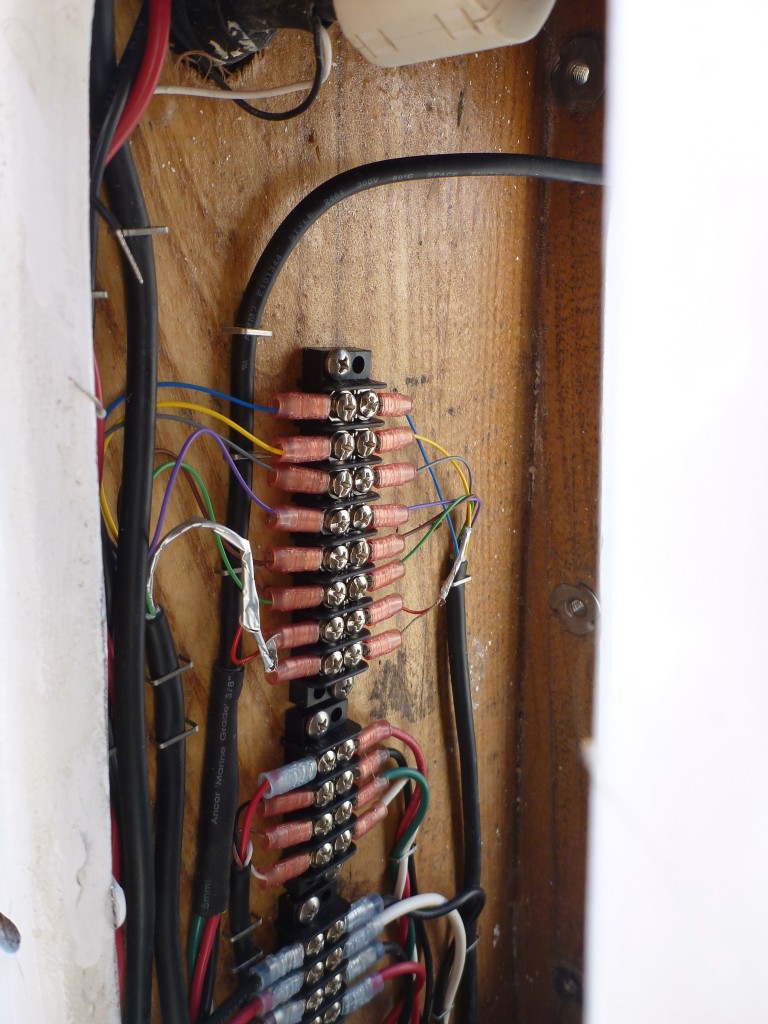
As I mentioned, removing the swing keel requires removing the binnacle, which in turn requires cutting a bunch of wires. Rather than ever have to deal with that again, this time I added terminal blocks and ring terminals to all of the wires, so that they can be easily disconnected and reconnected. I’m a big fan of well-organized wiring!

The last step to painting a boat is always the boot stripe – a quick splash of color parallel to the water line. Jim Brown, the designer of the Searunner trimarans, says that a boot stripe can make the difference between a home-built backyard boat and a jaunty yacht, and so for the past two paintjobs we’ve added a grey stripe at the end. I am extremely fond of how this looks.

Apparently when you repair a keel you should use more fiberglass and less filler, as I discovered painfully when we finally got the boat ready to be lifted up and put back in the water. My repairs just didn’t stand up to the pressure of lifting the whole boat – this was actually good to find out; if we’d been lifted with a travelift this error never would have come to light, and then next time we ran aground we’d be faced with a much larger problem. The trailer was pulled away and we spent an extra few days in the yard grinding and fiberglassing.

FINALLY, two months to the day since we’d been hauled out, we were back into the water. Of course, there was a strong wind blowing and as we drifted away we were blown right back into the shore, forcing the boatyard owner and his employees into the water, fully clothed, to help push the TIE Fighter back out into open waters before she ground onto the rocks… ahhh, memories.
More to come…
So exciting to see you getting her out again.
Dude your new swing-keel is a thing of beauty, also reading up on your EchoMax really gets my nerd senses tingling.
You guys are awesome and once again I’m left envious of your life of adventure.
Cheers!
Tie Fighter looks great! Good work. Will be doing the same as soon as I get back to Guaymas. Look forward to picking and drinkin’ those tasty drinks of Miyas!
Cheers,
Chris